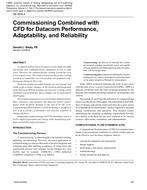Load-bearing masonry buildings are a significant portion of the existing building stock, and there is a great deal of interestin adding thermal insulation to the walls of these structures. Exterior insulation provides the ideal conditions for building durability;however, many buildings cannot be retrofitted with insulation on the exterior for reasons such as historic preservation,aesthetics, zoning, or space restrictions. Adding insulation to the interior side of walls of such masonry buildings in cold, andparticularly cold and wet, climates may increase risks of performance and durability problems.
A circa 1917 construction mass masonry building located on a Boston-area university campus was retrofitted with interiorpolyurethane spray foam insulation. Sensors were installed in the retrofitted walls to measure temperature and moisture conditionswithin the assembly; interior and exterior boundary conditions were also monitored. Experimental variables included orientation,spatial location of monitoring, and assembly type (insulated experimental versus uninsulated control). Hygrothermal simulationswere run on the original and retrofitted assemblies using measured site environmental data, both to assess durability risks, andfor comparison with the measured data.
Measured data indicated that the insulated masonry walls were colder and had higher moisture contents than uninsulatedassemblies, as would be expected. Hygrothermal simulations had good correlation to temperature measurements, but moisturemeasurements were less consistent. These differences may be due to sensor response, driving rain exposure, or anomalies withinthe mass masonry wall assembly. The simulations indicated a low risk of freeze-thaw damage.The effect of thermal bridging through structural elements (uninsulated floor slabs) was examined with cold weather infraredthermography.
Presented at Thermal Performance of Exterior Envelopes of Whole Buildings XII, December 2013
Citation: Thermal Performance of Exterior Envelopes of Whole Buildings XII
Product Details
- Published:
- 2013
- Number of Pages:
- 16
- File Size:
- 1 file , 12 MB
- Product Code(s):
- D-BldConf13-06


